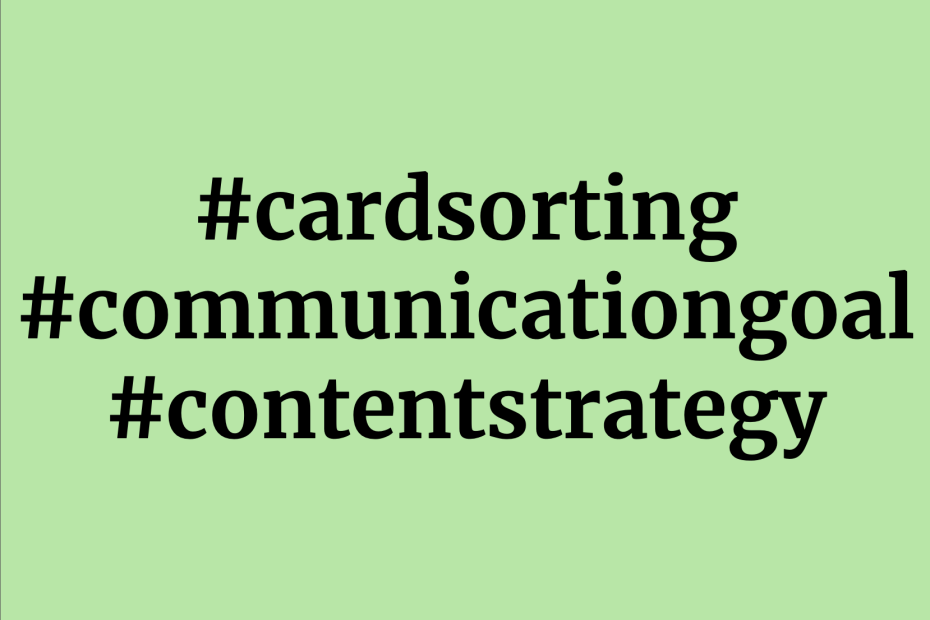A team willing to discuss for an hour or two. A set of cards with adjectives. A prepared facilitator. That is all you need to find your brand’s communication goals. And align your team in the process.A team willing to discuss for an hour or two. A set of cards with adjectives. A prepared facilitator. That is all you need to find your brand’s communication goals. And align your team in the process.
With those elements, you can conduct a Card Sorting exercise created by expert in brand-driven Content Strategy, Margot Bloomstein. Through the exercise, it is possible for the facilitator of the exercise to create what Bloomstein’s has called a Message architecture. This is, an outline or hierarchy of communication goals that reflects a common vocabulary, that helps content creators to know what messages their words and images should convey and the order of importance of those messages.
The exercise consist of three steps.
1. The participants are presented with a set of 80+ “post-it” or cards; each of them has an adjective. They need to read and organize the cards in three sections: “who we are today”, “who we are not”, and “who we would like to be”.
2. The participants discuss which adjectives from the “today” section should also be considered in the future and move the respective cards to the section “who we would like to be”.
3. The participants focus on the section “who we would like to be” and organize the adjectives by groups that make sense for them. Once they have organized them, they prioritize, by defining what are the main priorities to communicate the brand to the users.

After the exercise, and with the priorities and elements of the discussion at hand, the facilitator can produce a message architecture.

Three benefits of the card sorting exercise
I have conducted the exercise twice in 2023, once with a private company, and recently with a non-profit initiative. In both cases I have seen positive outcomes. Here are the three most important ones.
1. Align your internal team
The card sorting exercise to create a message architecture generates discussions that can help you aligning your internal team around a common vocabulary of terms that are important for your brand. This definition can help you finding a common ground across departments.
To illustrate the discussion, image a group of five c-level executives discussing for around 10 minutes about how they could be seen “serious”, which was important for a team, but also “fun”, which was important for other. The discussion was around a key aspect for they brand: how could they be fun without sounding foolish, and how could they be serious with being boring?
In another case, I have seen a group of leaders of a non-profit initiative discussing for around five minutes about whether being “historic” was less or more important than being “welcoming”.
2. Visualize your communication goals
The card sorting exercise is mostly visual, with cards and sections. By organizing the cards in groups at the end of the exercise, the participants can easily visualize which groups of concepts are more important than others.
As the next image shows, at the end of the exercise a team decided that many cards they had moved to the “who we would like to be” section were not as relevant as they initially thought and left them on the side of the board. By reading the rest of cards group, the team was able to define its priorities by assigning numbers to them.

3. Define a common vocabulary for your communication strategy
The exercise allows the participants to discuss and define a common vocabulary for the communication strategy of a brand.
For example, I have seen how the term “fun” has differing meanings for different people. For ones it means providing an enjoyable experience; for others, it means to be playful; and for others, it means to make people laugh.
This example shows that, when “being fun” is important for an organization, a card sorting exercise can help to find a common definition of the term. In turn, that can help setting the tone for the communication of the brand to its users, in elements such as images (should the people in an image seen laughing or not?) and texts (should texts on the website include concepts like “have fun” or “enjoy”?).
I can recommend the card sorting exercise to every organization that seeks to set a communication strategy, a content strategy, or set the tone for a new website or app. If you are interested in learning more details about how to conduct the exercise, I recommend you reading my colleague Dora Kramser’s post “It’s all about your brand’s message architecture”. And if you have time, I highly recommend you reading Margot Bloomstein’s book “Content Strategy at work: real world stories to Strengthen Every Interactive Project”. It offers several examples on how and why to develop a message architecture, and how the results from the card sorting exercise can help an organization to better communicate its brand to its users.
